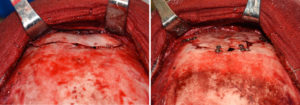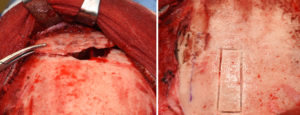Background: While men have greater brow bone prominences than women, there are cases where the brow bones do overgrow. When they do so the brow bone appear too prominent (Neanderthal-like), the forehead appears retroclined and one’s appearance is harsh or angry looking. While there are different degrees of brow bone hypertrophy in men, ultimately all that matters from a surgical standpoint is whether the individual thinks they are too big.
All male brow bone reductions in my experience require a bone flap setback technique and not just bone burring. The bone over the frontal sinus is not thick enough to allow for more than a few millimeters of retrusion. Removing the bone over the frontal sinus allows for a more significant reduction through the combination of perimeter burring reduction as well as bone flap thinning and reshaping.
In the bone flap brow bone reduction method, ensuring adequate bony coverage of the frontal sinus is important. While no bone flap method ever achieves an air tight seal when replaced, and some small bone defects around the perimeter are always tolerated and go on to heal, larger defects should they occur must be reconstructed.
Case Study: This young male was bothered by his large brow bone protrusion. He reported a history of it growing in the last few years as it did not look protrusive when he was younger. While he had a mildly retroclined forehead above the brow bones, their prominence magnified that effect.



Case Highlights:
1) Significant brow bone reduction requires a bone flap removal, reshaping and replacement approach.
2) Brow bone flaps require burring of both the surrounding bone prior to replacement as well as thinning of the bone flap itself.
3) In rare cases a cranial bone graft may be needed to fill in any large bone defects of the frontal sinus.
Dr. Barry Eppley
Indianapolis, Indiana




